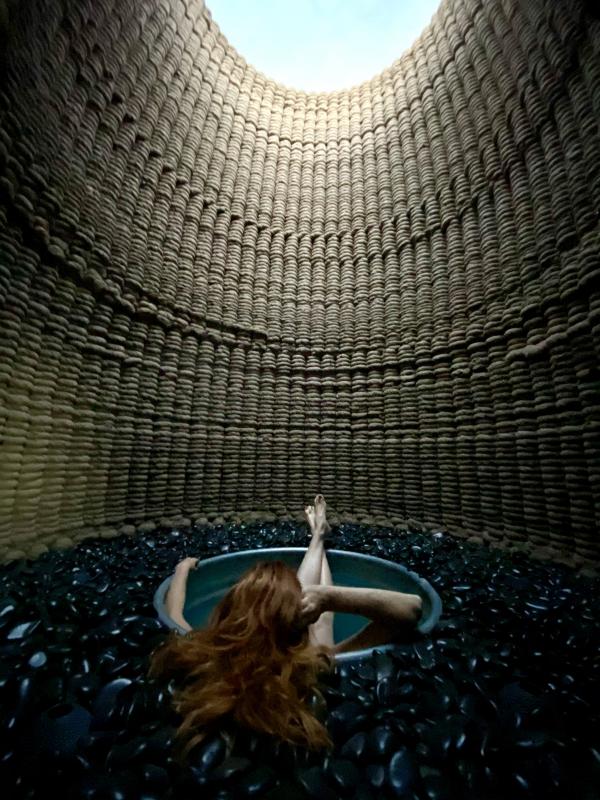For their Art + Technology Lab project, MUD Frontiers / Zoquetes Fronterizos, grant recipients Virginia San Fratello and Ronald Rael are re-examining Indigenous mud-based materials through 21st-century robotics. The artists hoped to work in Los Angeles, and examine the city's past in relation to its historic adobe building stock, but COVID-19 has caused them to put their travel plans on hold and pursue their work remotely. We caught up with San Fratello and Rael at their studio in southern Colorado where they have been building a new structure they call Casa Covida.
Your practice has a way of renegotiating relationships between things that are seemingly disparate. Whether it is combining robotically-controlled additive manufacturing and traditional adobe construction, as with Mud Frontiers / Zoquetes Fronterizos, or fabricating teeter-totters that transform a border wall into an international children's play set (Teeter-Totter Wall), the methods are playful but also radical. Has this always been the case with your practice?
The work we do often seems to come from and go to many different places and can possibly be seen as disparate, but there is one thing that many of our projects have in common and that is we are often looking at interventions. We intervene in landscapes such as the borderlands between the USA and Mexico. We have intervened there by inserting the pink teeter totters into the border wall with the hope of altering the way people see the residents of the border communities and as a way of improving the function of the wall. We have also intervened in the proprietary material market of 3D printing and additive manufacturing by using very low cost, and sometimes free, materials as substitutes for the more expensive materials that are sold to be used with 3D printers. By intervening in this market, we are attempting to lower the bar and make this technology more accessible and affordable to more users. We do think this is something we have always done in our practice, maybe not knowingly in the beginning, but we're often looking for ways to mediate or intercede as a way of commenting on social and political situations, as a way of provoking or encouraging others to rethink current practices and assumptions, and even as a way for us to think about how we continue to push ourselves creatively into new territory.
Since COVID-19 hit, you have been working out of your studio in southern Colorado. Please tell us about the history of this location. How does Casa Covida fit into the larger narrative of this place? Does the work you make in Colorado differ from that you create in California?
We are working from the San Luis Valley in southern Colorado, an alpine desert that is the headwaters of the Rio Grande river and prior to the Mexican-American war, it was the northernmost frontier of Mexico. This landscape is harsh and was not permanently settled until the mid 1800s, but was the seasonal hunting grounds of the Ute, Pueblo, Kiowa, and Jicarilla Apache, as well as sacred land to the Navajo. Most of the buildings up until the 1950s were constructed of mud, including our home base, which has been in our family for six generations. Our work with 3D printing takes on the material culture of the region, micaceous pottery and adobe are reimagined through contemporary technology, building upon ancestral traditions in new ways, creating a hybrid form of craft that is essential to what defines the borderlands—a landscape of hybrid conditions where languages, foods, beliefs, and knowledge from different sources and different times come together.
California is also an expanded borderland with similar traditions rooted in making with local materials that combine Indigenous and contemporary knowledge bases. What we make in California is different from the perspective that we work more there in a lab because of our lack of land, however, our aim is the same, to think about how we can use local materials to create contemporary objects. In the case of California, we experiment with the materials of the region—grape skins, salt, and sawdust, for example—in the same way we experiment with local soils in Colorado.
Casa Covida Project Team:
Ronald Rael & Virginia San Fratello
Sandy Curth
Logman Arja
Mattias Rael
Custom Textiles by:
Josh Tafoya
The Art + Technology Lab is presented by
The Art + Technology Lab is made possible by YouTube Learning, and Snap Inc.
Additional support is provided by SpaceX.
The Lab is part of The Hyundai Project: Art + Technology at LACMA, a joint initiative exploring the convergence of art and technology.
Seed funding for the development of the Art + Technology Lab was provided by the Los Angeles County Quality and Productivity Commission through the Productivity Investment Fund and LACMA Trustee David Bohnett.




